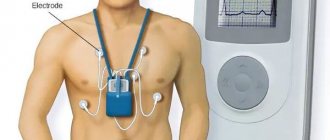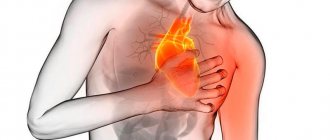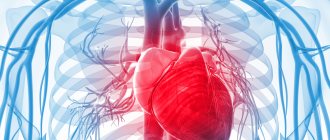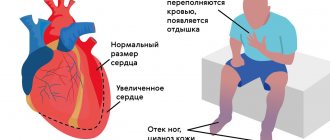Most cases of angina are associated with a sharp increase in the level of physical or psycho-emotional stress. However, there are exceptions to this rule. Thus, Prinzmetal's angina, also called variant, vasospastic or spontaneous, usually develops in a patient who is at rest. The typical time for symptoms to occur is between midnight and the wee hours of the morning. The pain syndrome is intense, spreading to the head or arms, reminiscent of signs of seizures. It is more often observed in smokers, patients with high cholesterol or blood pressure, but can also occur in healthy people. Thanks to modern diagnostic methods and a thoughtful course of treatment while eliminating bad habits or factors, it is possible to significantly reduce the frequency of attacks and make them less painful.
Causes of Prinzmetal's angina
Coronary artery spasm can occur in the following cases:
- hypothermia of the body;
- smoking;
- symptoms of arterial hypertension;
- stress;
- increased cholesterol levels;
- taking medications that slow blood flow;
- consumption of alcohol and drugs.
The disease is more common in patients aged 50 to 60 years. 5 times more common in men than in women. Smoking and alcohol consumption are recognized as the main risk factors. Less commonly, the pathology develops against the background of vasomotor vascular disorders.
Forecast
Currently, this disease is considered by cardiological communities as a form of progressive coronary insufficiency similar to unstable angina. Consequently, the long-term prognosis of the pathology will, to put it mildly, not be the most optimistic. In 20% of cases, acute myocardial infarction (“heart attack”) develops in the first six months, and 10% of patients experience death. A long-term remission may occur with a resumption of symptoms years later. Sudden coronary death occurs in 0.5% of cases. The risk of complications depends on the following factors:
- frequency and severity of anginal attacks;
- current condition of the coronary vessels;
- adequacy of drug therapy;
- patient compliance, especially with regard to lifestyle correction.
Prinzmetal's angina (variant, vasospastic) today is a reason for scientific debate, because the question of the clarity of the pathogenesis of the disease remains incompletely studied.
Symptoms of Prinzmetal's angina
The list of characteristic symptoms of vasomotor angina includes:
- pain in the chest at rest, which can be of a different nature - from some discomfort to severe pain radiating to the head or arm;
- feeling of pressure and tightness in the chest;
- attack of nausea;
- sweating;
- dizziness, clouding of consciousness;
- tachycardia, etc.
The duration of the attack ranges from 2 to 20 minutes, and the characteristics of individual episodes are usually similar to each other. Cases of relapse with frequent attacks may be followed by a state of calm for several weeks or months.
Are you experiencing symptoms of Prinzmetal's angina?
Only a doctor can accurately diagnose the disease. Don't delay your consultation - call
Clinical case
In 2021, a 42-year-old man came to me with complaints of recurring attacks of anginal pain, mainly at 4:00 - 5:00 in the morning and much less often during the daytime.
Connects their appearance with stressful situations that arise at work and at home. Smoking has been a bad habit for the last 30 years. History of peptic ulcer of the gastric antrum and duodenal bulb. General examination and auscultatory picture are without any features. There was a slight increase in blood pressure to 135/85 mm Hg. Blood test showed Hb 169 g/l, erythrocytes 5.7 cells/l. Clinical examination of urine is unchanged. During a 3-day Holter monitoring of the electrocardiogram during the next night attack, ST segment elevation of up to 6 mm in the precordial leads was noted, followed by restoration to the isoline upon its completion. The diagnosis was made: IHD. Prinzmetal's angina pectoris NCo CHO (NYHA) . Treatment with a calcium channel antagonist, Verapamil, was prescribed; during the attack, the use of nitrates in the form of a spray (Nitromint) was allowed. A complete cessation of smoking was also recommended.
The patient returned again 2 months later and noted a noticeable improvement in his general condition and the complete disappearance of night and daytime attacks.
Do you have friends or relatives who are bothered by night attacks of chest pain? Share your experience in the comments, and our expert will express his opinion.
Methods for diagnosing the disease
Suspicion of Prinzmetal's angina arises in any case if the patient complains of sharp chest pain at rest or at night. The diagnosis implies that the duration of attacks can range from 30 seconds to 5 minutes, and their number varies up to several dozen within half an hour. In addition, an indirect sign is the subsidence of pain when taking sublingual drugs with a nitrate chemical composition.
The initial assumptions can be confirmed by:
- electrocardiogram in the format of a one-time study or daily monitoring;
- provocative pharmacological tests.
Signs of illness
Prinzmetal's angina has become a separate nosological entity due to the differences in the pathogenesis and clinical course of the disease. The basis of the classic “angina pectoris” is myocardial hypoxia, which occurs due to blockage of the heart vessels with atherosclerotic plaques. Variant angina appears as a result of a sharp, sudden, transient spasm of one of the large branches of the coronary artery. As a result, the lumen critically narrows, which is why the heart muscle does not receive the necessary oxygen.
The presence of atherosclerotic altered vessels is not a mandatory factor, but in such patients its initial signs can be diagnosed.
The following important reasons also influence the development of pathology:
- changes in the rheological properties of blood (fluidity, viscosity);
- abnormal hyperreactivity of the coronary arteries supplying the heart;
- dysfunction of the endothelium, the internal biologically active lining of blood vessels, resulting in a decrease in the production of nitric oxide, which affects vascular tone;
- a decrease in the secretion of estrogens (female hormones), which explains the increase in the number of postmenopausal patients.
A significant difference between vasospastic angina, which, in my opinion, should be given special attention, is that it affects the working age group from 35 to 50 years. In many cases, its complications cause disability. The prognosis for full recovery is disappointing.
Of the most common complaints presented by patients with Prinzmetal vasospastic angina, I can highlight the following:
- paroxysmal pain in the chest area lasting about 20 minutes or more, which can radiate to the left half of the body. There may be periods of increasing and decreasing sensations, a series of 2 - 4 attacks;
- interruptions in the functioning of the heart associated with the presence of cardiac arrhythmias (tachycardia, extrasystole, atrial fibrillation, etc.);
- nonspecific manifestations - dizziness, lightheadedness, increased sweating, headache, respiratory failure.
I would like to draw your attention to the fact that the attacks are cyclical and occur more often between 4 and 6 am. At the end of the attack, all symptoms disappear, and patients feel absolutely healthy.
I noted that in most cases there are no provoking factors, but they may be:
- emotional shock;
- hypothermia;
- smoking;
- taking stimulant drugs such as Ephedrine, Amphetamine.
Prinzmetal's angina has quite specific symptoms and making the correct diagnosis is not difficult for a competent specialist. But it is worth remembering that several pathologies can exist together. How to understand the cause of pain? Fixed anatomical stenosis of the coronary vessels, which occurs against the background of atherosclerosis, gives attacks provoked by physical activity and stress, more often in the daytime. In turn, vasospastic angina pectoris causes coronary spasm, often at night.
Treatment of Prinzmetal's angina
A course of medication that affects both the symptoms of the disease and its causes can help cope with attacks and reduce their regularity. Clinical recommendations for Prinzmetal angina include:
- taking drugs from the category of calcium antagonists in combination with long-term nitrates;
- anti-alpha adrenergic drugs that prevent coronary artery spasm;
- a course of antioxidant vitamins C and E;
- other medications that promote the natural elasticity of blood vessels and maintain their conductive capacity.
If a conservative course turns out to be ineffective, doctors resort to surgical intervention. More often this is coronary angioplasty with stenting, less often cardiac denervation with plexectomy simultaneously with coronary bypass surgery. A decision may be made to implant an automatic defibrillator or pacemaker.
How to treat angina pectoris at home?
ETHNOSCIENCE
To treat angina pectoris at home, mainly decoctions and mixtures are used. They should include agents with an anticoagulant effect, that is, preventing rapid blood clotting,
as well as cardiotonic drugs - they improve blood circulation.
The list of such drugs includes: hawthorn, rose hips, motherwort, fruits and herbs of dill, roots and herbs of chicory, rhizomes and shoots of asparagus.
Recipes
- Take seven tablespoons of a mixture of hawthorn berries and rose hips, pour two liters of boiling water, wrap in a warm cloth and leave for a day. Strain, squeeze out the swollen berries and put the infusion in the refrigerator. Drink a glass a day with meals for 2-3 weeks.
- Place seven tablespoons of hawthorn berries (whole or chopped) and seven glasses of boiling water in a jar. Then close the jar and wrap it, put it in a warm place for a day. After infusion, strain the medicine, place it in the refrigerator and take three glasses a day with meals. You can add 1-2 tablespoons of rose hips to the preparation for sweetness and increasing the vitamin C content. At the beginning of treatment, you can mix hawthorn berries with motherwort herb in equal proportions, and then you can use only hawthorn berries.
- Hawthorn fruits, sweet clover herb, wild strawberry - two parts each, calendula flowers, meadowsweet herb, lemon balm herb, rue herb, yarrow herb, dill fruits, immortelle flowers - one part at a time (8 g of collection) pour 300 ml of boiling water, heat over water bath without boiling for 15 minutes, leave in a warm place for two hours, strain. Take everything 4-5 times warm an hour before meals and the last time an hour before bedtime. For night attacks, take half a glass hot.
- Take two parts of caraway fruits, periwinkle leaves, three parts of rhizomes with valerian roots, lemon balm leaves, four parts of hawthorn flowers, six parts of mistletoe leaves. Pour a tablespoon of the mixture into a glass of boiling water, leave for two hours and strain. Take two glasses a day for angina pectoris.
- Mix two parts of wild strawberries and one part each of lingonberry leaf, yarrow herb and dog violet herb. Pour a tablespoon of this mixture into a glass of boiling water, leave for an hour and strain. Drink half a glass three times a day.
- Take two parts of canine violet herb and one part of the rhizome with valerian roots. Pour a tablespoon of the mixture into a glass of boiling water, leave for an hour, strain. Take half a glass of the folk remedy three times a day.
TREATMENT OF ANGINA WITH GARLIC
Like hawthorn, garlic occupies a special place in the treatment of angina. It is ineffective in combating angina pectoris, but it seriously helps prevent coronary heart disease, as it fights atherosclerosis and cholesterol plaques.
Recipes
- Grind 200-300 grams of peeled garlic cloves into a paste and mix with the same amount of honey. The mixture is sealed in a jar and infused for at least a week. Take a tablespoon three times daily before meals (30-40 minutes). The course can last up to 3 months.
- For angina pectoris, ascorbic acid is indispensable. You can add freshly squeezed lemon juice to the honey-garlic mixture, and this will only increase its medicinal qualities. You will need 10 lemons, a kilogram of honey and 10 large heads of garlic. This mixture is infused for the same amount of time, a week, and taken 3-4 teaspoons once daily. It is important to take your time and take at least a minute break after each spoon.
- You can boil thick chicken broth and pour two glasses of it into a dozen large cloves of garlic. Then the broth is boiled for 15 minutes, and about 50 g of parsley is added three minutes before removing from the heat. Boiled garlic and parsley are ground through a fine sieve and mixed again with the broth. This is a ready-to-use product that is useful to drink 75 ml half an hour before meals.
FAQ
What does Prinzmetal's angina mean?
This is the name of a separate type of angina, the main symptom of which is severe pain during the patient’s rest or night sleep. The main reason is a short-term spasm of the coronary artery, as a result of which the blood flow sharply slows down. But the heart muscle, maintaining the same rhythm of work, is forced to contract even more intensely, which gives a characteristic pain syndrome.
How does Prinzmetal's angina manifest?
It is not easy to miss an attack of the disease: it makes itself felt by a sharp pain in the heart area, which radiates to the head, shoulder or arm. You feel nausea, difficulty breathing due to a feeling of pressure in the chest, dizziness, and a sharp increase in heart rate. Sometimes patients complain of nausea and sweating.
Description
Prinzmetal's angina is a disease characterized by cyclical attacks of chest pain resulting from spasm of the arteries supplying blood to the heart muscle.
In medical practice, you can find other names, such as variant, spontaneous, vasospastic angina. It was first described by the American cardiologist M. Prinzmetal in 1959. In total, about 3% of patients with coronary heart disease suffer from the pathology. According to my personal observations, the disease is more often found in heavy smokers who have diseases such as:
- arterial hypertension;
- peptic ulcer;
- chronic hepatitis of viral and toxic etiology.
What can the disease be confused with?
As for diseases not related to the cardiovascular system, based on the symptoms and signs, angina pectoris can be mistaken for:
- osteochondrosis of the cervical or thoracic spine;
- vegetative-vascular dystonia;
- gastrointestinal diseases (diaphragmatic hiatal hernia);
- pleurisy, pulmonary embolism;
- pinched nerves.
Usually this disease is confused with the onset of myocardial infarction. The signs are really very similar. The main difference is that an attack of angina is relieved by taking nitroglycerin. In case of a heart attack, the medicine does not work or relieves pain only slightly and temporarily.
Risk factors for developing angina
The following factors lead to narrowing of the coronary vessels and insufficient blood supply to the myocardium:
- atherosclerosis - deposition of cholesterol plaques in the walls of blood vessels;
- hypotension ー low blood pressure;
- coronary artery thrombosis;
- age-related changes in blood vessels.
In the vast majority of cases, angina is caused by atherosclerotic lesions of the coronary arteries. It develops due to disturbances in the metabolism of cholesterol and other lipids: excess animal fats in the diet, lack of plant foods. Therefore, proper nutrition is the basis for successful prevention of angina pectoris.
Nicotine also constricts blood vessels, so smokers develop angina more often.
The risk group for the development of angina pectoris includes:
- people over 55 years of age;
- men;
- smokers;
- people who abuse alcohol and drugs;
- people with pathologies of the cardiovascular system (heart defects, heart failure);
- with pathologies of the respiratory system (bronchial asthma, chronic obstructive diseases);
- overweight.
All these factors increase the risk of developing atherosclerosis, cardiac ischemia and angina. Most of them can be eliminated through lifestyle changes.
Where can I get diagnosed and treated?
Rest assured that your heart is not in danger! If the first symptoms and signs of angina appear, consult a qualified healthcare provider. Cardiologists at the CBCP Center for Circulatory Pathology are ready to help you. The clinic will offer professional consultation and modern types of diagnostics, through which the doctor will receive objective, detailed and accurate information about the disease.
If you discover serious violations, do not despair! The level of medicine at CBCP makes it possible to effectively treat complex cardiovascular diseases using medicinal and non-surgical methods.








